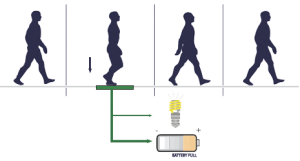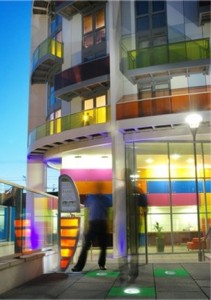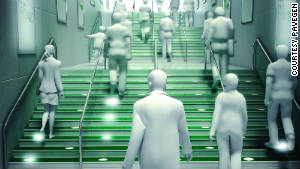The world today is constantly struggling to find new, environmentally friendly ways to generate energy. The major power sources today include oil, gas, coal, hydroelectric, and nuclear power. Until recently no one has thought to use everyday life to help generate usable energy.
Laurence Kembell-Cook, director of Pavegen Systems, has had the ingenious idea to harvest electrical energy from pedestrian’s footsteps. He is going to use sidewalk tiles that will be connected to a lithium battery to supply energy to electrically powered devices in the surrounding area. This could range from traffic lights to advertisement boards on sidewalks or supply energy to light up displays at the mall.
The basic design is outlined in Figure 2 and a demonstration of the Pavegen tile system can be found online . The pedestrian will step on the tile, displayed in Figure 3, which will cause it to glow, just like the tiles in Michael Jackson’s “Billie Jean” music video. The five-millimeter compression will initiate a mechanism (unreleased to the public) which allows the kinetic energy to by converted to usable electricity. The tile can also store the energy for up to three days in an onboard battery. Each step on one of these tiles contributes 2.1 W per hour of electricity. Out of the energy the tile absorbs, only five percent goes into lighting up the tile leaving 95 percent of the energy to be used elsewhere. Personally, I believe the energy to light the tile is significant as it gives people a positive reinforcement,which may increase their participation. However,

it also could be argued that energy lighting the tile is wasting energy that could be used elsewhere which I also recognize. The tile itself is made of nearly 100 percent recycled materials, mostly consisting of rubber and some stainless steal which both contribute to its durability. These tiles are designed to be weather resistant, water-resistant, and are easily added to existing structures. The company claims the lifespan of each tile is approximately 5 years or 20 million steps.
The first commercial application will be placing 20 tiles across a very busy intersection in London between London’s Olympic stadium and the newly opened Westfield Stratford City mall. The opening of the mall alone is estimated to bring in around 30 million customers within the first year, that’s a lot of steps!
The aim of this project it to collect a small amount of energy from a large number of people. The growth of this technology will rely heavily on the tiles production costs. If this project gets approved the company hopes to introduce this technology into subway stations, malls, or any other high traffic areas. I believe this would be a fantastic venture for our society so we can finally take a stand, or a stroll, towards helping generate clean energy in the future.



